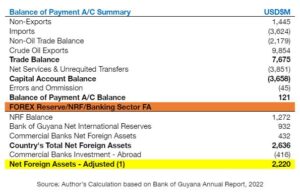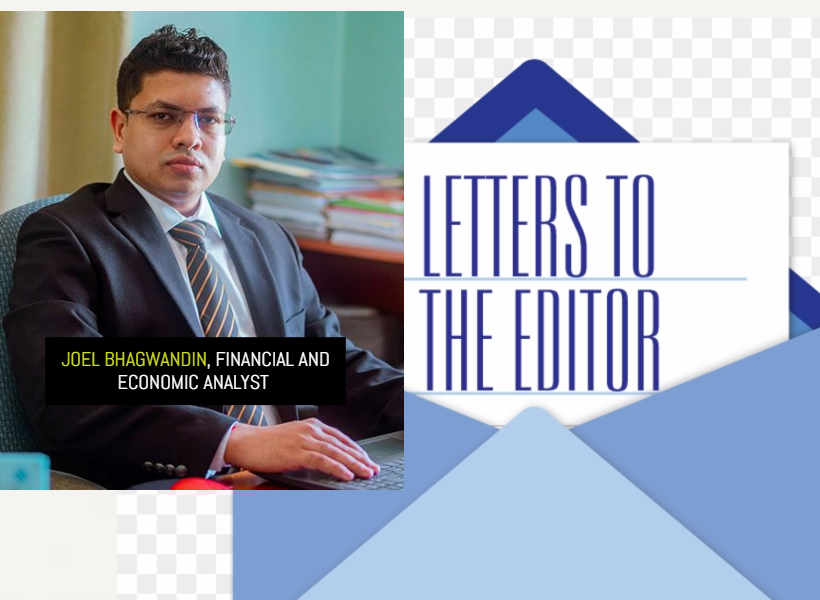Dear Editor,
Despite the relatively large forex (foreign exchange) earnings from the petroleum sector, the capital account and net services and unrequited transfers continue to record large deficit balances (forex outflows of US$7.6 billion), resulting in a relatively small surplus balance in 2022, which represented 0.9% of GDP (2022). This is one of the factors responsible for the exchange rate stability that prevails.
Of recent, several writers, both locally and regionally and from within the Guyanese Diaspora have been advancing the argument on whether the Guyanese currency should be revalued. This notion is against the backdrop of the foreign exchange (FOREX) earnings from the country’s oil and gas resources. More specifically, the Peeping Tom column of the Kaieteur News edition of August 12th, 2023, questioned why the exchange rate has not appreciated substantially as yet, given that earnings from the oil resources is pegged at US$1 billion for this year, and export earnings in 2022 increased from US$1.56 billion in 2018 to US$11.2 billion at the end of 2022. The author of the Peeping Tom column intimated that the dominant players in the forex market control the exchange rate. This notion, however, is partially correct. The columnist then concluded that it is in the government’s interest to maintain the exchange rate at around the present levels.
In theory, large inflows of foreign exchange tend to trigger a substantial increase in the exchange rate, especially where there is a floating exchange rate regime. In the case of Guyana, the exchange rate regime can be characterized as a managed float. A substantial appreciation of the exchange rate would necessitate a change in relative prices; considering that Guyana imports about 80%-90% of consumer, intermediate and capital goods. This description is precisely what is known as the “Dutch disease”, a paradox which the government must avoid at all cost. So, when Peeping Tom argued that it is in the government’s interest to maintain the exchange rate at current levels, he is partially correct as well. In fact, it is more so in the country’s interest to maintain a stable exchange rate environment. A sharp appreciation of the exchange rate can cripple the export/manufacturing sectors at the expense of the importers. In other words, imports will become far cheaper, while export commodities will become more expensive, hence, a loss of international competitiveness in global markets.
That said, let’s examine why there is no major appreciation of the exchange despite massive increases in exports on account of the petroleum sector (crude oil export), and the forex earnings to the Natural Resource Fund (NRF). The answer to this question resides in analyzing the sources of inflows and outflows of forex, to derive the net flow of forex, together with the foreign reserve balances of the country, and net foreign assets of the banking sector. The table below and the discussion that follows, deals with this aspect.
First, it is important to understand that the external trade balance which is a surplus of US$7.65 billion (the difference between exports and imports), and the balance of payment surplus of US$122 million at the end of 2022, are accounting balances and not the actual balances. The reason for this distinction is because the total export earnings include export of crude oil which reflects 100% of the crude oil produced in Guyana. But the country does not earn in actuality, 100% of the forex from crude oil sales. Notably, 75% of this sum is cost oil, of which local content spend in country for 2022 represents 7% of total crude oil exports. The government’s share is in the form of the 50% profit and 2% royalty payments.
Second, the government’s share as alluded to above, is deposited into the NRF that is held outside of the country at the Federal Reserve Bank.
With this in mind, it is important to note that in order to derive a true picture of the net forex inflow/outflow to the country, the external trade balance should be adjusted accordingly. As illustrated in the foregoing table, the non-oil exports at the end of 2022 amounted to US$1.445 billion, imports amounted to US$3.624 billion, giving rise to a non-oil trade balance deficit of US$2.179 billion. For the same period, the net private sector balance which includes foreign direct investment (FDI), recorded a net outflow of US$3.110 billion. Of this sum, US$3.053 billion represented payment for the acquisition of the Liza Unity FPSO in 2021. Net remittances for the period amounted to US$22 million, forex inflow from external debt disbursements amounted to US$261 million and outflow for external debt service payments amounted to US$85 million. These, altogether, gave rise to a net (forex) outflow position of US$4.483 billion, as shown in the table attached.
Additionally, the NRF balance as of the end of 2022 stood at US$1.272 billion, the net international reserve at the Bank of Guyana stood at US$932 million, the commercial banks net foreign assets stood at US$432 million, giving rise to a total net foreign asset position of US$2.636 billion. Consequently, when placed against the net outflow of forex based on the foregoing transactions, the net (adjusted) forex position inclusive of the net foreign assets in the banking sector is a deficit position of US$1.847 billion. Put simply, this means that despite the relatively large forex earnings from the petroleum sector, when the necessary adjustments are made to arrive at the actual position versus the accounting balances, the outflow of forex remains greater than the inflow of forex, resulting in a net outflow position.
This, is one of the factors responsible for the exchange stability that prevails. The other factors that contribute to the exchange rate stability are attributed to the following:
The commercial banks invest between 70% – 96% of their net foreign assets in financial markets abroad
The Bank of Guyana’s net foreign assets are held outside of the jurisdiction, and_
The NRF is also held in an account outside of the jurisdiction.
As such, the domestic market is not flooded with forex, all of which helps integrally in maintaining a stable exchange rate. And this is far more important for the economy than revaluation of the currency at this time.
Notwithstanding, the exchange rate has been appreciating―albeit not substantially, but incrementally, as shown in the chart attached.
By and large, the average market exchange rate has been stable over the last fifteen years, thus enabling macroeconomic stability. During the period 2015-2020, the exchange rate depreciated by $7.97 or 3.8%. Conversely, for the period 2021-2022, the exchange rate appreciated by almost the same level of 3.8%, thereby reverting to its pre-2015 level. With increasing inflows of forex from the NRF and the oil and gas sector, the exchange rate is projected to appreciate marginally over the medium term.
As such, the domestic market is not flooded with forex, all of which helps integrally in maintaining a stable exchange rate. And this is far more important for the economy than revaluation of the currency at this time.
Yours respectfully,
Joel Bhagwandin













